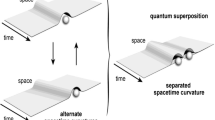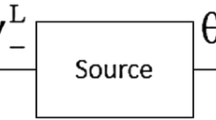Abstract
If conscious observers are to be included in the quantum mechanical universe, we need to find the rules that engage observers with quantum mechanical systems. The author has proposed five rules that are discovered by insisting on empirical completeness; that is, by requiring the rules to draw empirical information from Schrödinger's solutions that is more complete than is currently possible with the (Born) probability interpretation. I discard Born's interpretation, introducing probability solely through probability “current.” These rules tell us something about brains. They require the existence of observer brain states that are neither conscious nor unconscious. I call them “ready” brain states because they are on stand-by, ready to become conscious the moment they are stochastically chosen. Two of the rules are selection rules involving ready brain states. The place of these rules in a wider theoretical context is discussed.
Similar content being viewed by others
References
R. A. Mould, “Consciousness: The rules of engagement, ” quant-ph/0206064.
R. A. Mould, “Schrödinger's cat: The rules of engagement, ” quant-ph/0206065.
R. A. Mould, “Conscious pulse I: The rules of engagement, ” quant-ph/0207005.
R. A. Mould, “Conscious pulse II: The rules of engagement, ” quant-ph/0207165.
J. von Neumann, Mathematical Foundations of Quantum Mechanics (Princeton University Press, Princeton, N. J., 1955), p. 351.
E. Joos and H. D. Zeh, “The emergence of classical properties through interaction with the environment, ” Phys. Rev. B 59, 223–243 (1985), p. 224.
D. Giulini, et al., Decoherence and the Appearance of a Classical World in Quantum Theory (Springer, New York, NY, 1996), pp. 41–44.
C. Townsend and W. Ketterle, “Bose–Einstein condensation, ” Physics World 29–34 (March (1997).
E. A. Cornell and C. E. Wieman, “Bose–Einstein condensate, ” Sci. Amer. 40–45 (March 1998).
J. R. Friedman, et al., “Quantum superposition of distinct macroscopic states, ” Nature 406, 43–45 (2000).
R. Penrose, Shadows of the Mind (Oxford University Press, New York, NY, 1994), Sec. 6.12.
R. A. Mould, “Objective vs. observer measurements, ” Author's home page.
R. A. Mould, “The parallel principle, ” quant-ph/0111096.
R. A. Mould, “Consciousness and endogenous state reduction: Two experiments, ” Found. Phys. Lett. 14(4), 377–385 (2001), quant-ph/0106103.
Author information
Authors and Affiliations
Rights and permissions
About this article
Cite this article
Mould, R.A. Quantum Brain States. Foundations of Physics 33, 591–612 (2003). https://doi.org/10.1023/A:1023718603362
Issue Date:
DOI: https://doi.org/10.1023/A:1023718603362




